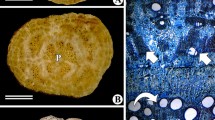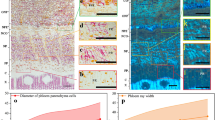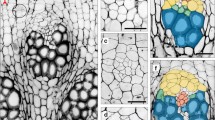Abstract
Bignoniaceae is known for the presence of different growth forms like trees, shrubs, lianas and herbs that show a wide range of variations in their wood structure. Trees, shrubs and lianas are characterised by the presence of normal secondary growth except the lianoid forms of the tribe Bignonieae that have a unique type of the cambial variant (that is, wedged/furrowed xylem) whereas other lineages lack it. Campsis radicans belongs to tribe Tecomeae and thus is expected to lack the cambial variant but it develops a quantifiable amount of intraxylary secondary xylem and phloem in the pith. Therefore, the main aim of the present investigation is to elucidate the ontogeny of intraxylary phloem and the secondary xylem formed by internal vascular cambium. Development of intraxylary phloem is delayed significantly as compared to other families of eudicots that show the presence of intraxylary phloem. Subsequently, a functionally bidirectional complete ring of internal vascular cambium initiates along the pith margin that produces secondary xylem centrifugally and secondary phloem centripetally. In thick stems, an internal vascular cambium forms quantifiable amounts of inversely oriented secondary xylem and phloem that completely replace the pith. Structurally, this secondary xylem remains similar to the xylem formed by the regular (external) cambium. It is composed of vessels, fibres, axial and ray parenchyma cells while the secondary phloem consists of sieve elements, companion cells, axial and ray parenchyma cells. The development of internal vascular cambium completely replaced the parenchyma of the pith by producing intraxylary secondary xylem and phloem. The reason for the occurence of intraxylary phloem in C. radicans remains unknown. However, to the lesser extent it may be playing a secondary role in conductive safety of the conduit.





Similar content being viewed by others
References
APG III (2009) An update of the Angiosperm Phylogeny Group classification for the orders and families of flowering plants: APG III. Bot J Linn Soc 161:105–121
Berlyn GP, Miksche JP (1976) Botanical microtechnique and cytochemistry. The Iowa State University Press, Ames
Carlquist S (1985) Wood and stem anatomy of Misodendraceae: systematic and ecological conclusions. Brittonia 37:58–75
Carlquist S (1988) Comparative wood anatomy, systematic ecological and evolutionary aspect of dicotyledonous wood. Springer-Verlag, New York
Carlquist S (2001) Comparative wood anatomy: systematic, ecological and evolutionary aspect of dicotyledon wood. Springer, New York
Carlquist S, Hanson MA (1991) Wood and stem anatomy of Convolvulaceae: a survey. Aliso 13:51–94
Ceccantini GCT, Alfonso VA (2000) Perforated ray cells in Bathysa meridionalis (Rubiaceae). IAWA J 21:77–82
Chalk L, Chattaway MM (1933) Perforated ray cells. Proc R Soc Lond B 113:82–92
De Bary A (1884) Comparative anatomy of vegetative organs of phanerogams and ferns. Oxford University Press, Oxford
Dobbins DR (1971) Studies on the anomalous cambial activity in Doxantha unguis-cati (Bignoniaceae). II. A case of differential production of secondary tissues. Am J Bot 58:697–705
Dobbins DR (2005) Development and function of included phloem in woody lianas of the Bignoniaceae. XVII International Botanical Congress Book of Abstracts, Vienna
Ellmore GS, Ewers FW (1985) Hydraulic conductivity in trunk xylem of elm, Ulmus Americana. IAWA J 6:303–307
Esau K (1938) Ontogeny and structure of the phloem of tobacco. Hilgardia 11:343–424
Ewers FW, Fisher JB, Fitchner K (1991) Water flux and xylem structure in vines. In: Putz FE, Mooney HA, Bullock SH (eds) Biology of vines. Cambridge University Press, Cambridge, pp 127–160
Fischer (2004) Bignoniaceae. In: Kubitzki K (ed) The families and genera of vascular plants, vol. VII. Flowering plants. Springer, Berlin, pp 9–38
Fukuda Y (1967) Anatomical study of the internal phloem in the stems of dicotyledons, with special reference to its histogenesis. J Fac Sci Univ Tokyo 9:313–375
Gentry AH (1992) A synopsis of Bignoniaceae, ethanobotany and economic botany. Ann Missouri Bot Gard 79:53–64
Gondaliya AD, Rajput KS (2016) Stem anatomy and development of intraxylary phloem in Vallaris solanacea (Roth) Kuntze (Apocynaceae). J Indian Bot Soc 95(1&2):16–27
Handa T (1935) Abnormal vascular bundle in the stem of Campsis grandiflora K Schum. Japan J Bot 8:47–58
Johansen DA (1940) Plant microtechnique. Mc Graw Hill, New York
Kennedy PB, Crafts AS (1931) The anatomy of Convolvulus arvensis, wild morning glory or field bind weed. Hilgardia 5:591–622
Metcalfe CR, Chalk L (1950) Anatomy of the dicotyledons. Clerendon Press, Oxford
Mikesell J, Schroeder AC (1984) Internal phloem development in Pharbitis nil Chois. (Convolvulaceae). Bot Gaz 145:196–203
Olmstead RG, Zjhra ML, Lohmann LG, Grose SO, Eckert AJ (2009) A molecular phylogeny and classification of Bignoniaceae. Am J Bot 96(9):1731–1743
Pace MR, Angyalossy V (2013) Wood anatomy and evolution: a case study in the Bignoniaceae. Int J Plant Sci 174(7):1014–1048
Pace MR, Lohmann LG, Angyalossy V (2009) The rise and evolution of the cambial variant in Bignonieae (Bignoniaceae). Evol Dev 11:465–479
Pace MR, Lohmann LG, Angyalossy V (2011) Evolution of disparity between the regular and variant phloem in Bignonieae (Bignoniaceae). Am J Bot 98:602–618
Pace MR, Lohmann LG, Olmstead RG, Angyalossy V (2015) Wood anatomy of major Bignoniaceae clades. Plant Syst Evol 301:967–995
Pace MR, Zuntini AR, Lohmann LG, Angyalossy V (2016) Phylogenetic relationships of enigmatic Sphingiphila (Bignoniaceae) based on molecular and wood anatomical data. Taxon 65(5):1050–1063
Patil VS, Rajput KS (2008) Structure and development of inter- and intraxylary phloem in Leptadenia reticulata (Retz.) W. & A. (Asclepiadaceae). Pol Bot J 53(1):5–13
Patil VS, Rao KS, Rajput KS (2009) Development of intraxylary phloem and internal cambium in Ipomoea hederifolia (Convolvulaceae). J Torrey Bot Soc 136(4):423–432
Patil VS, Koyani RD, Sanghvi GV, Rajput KS (2014) Structure and development of internal phloem in Solanum pseudocapsicum L. (Solanaceae). IAWA J 35(1):1–11
Pfeiffer H (1926) Convolvulaceae. In: Linsbauer K (ed) Handbuch der Pflanzenanatomie. 2. Abt., 2.Teil, Band 9. Borntraeger, Berlin
Philipson WR, Ward JM, Butterfield BG (1971) The vascular cambium: its development and activity. Chapman and Hall, London, pp 95–109
Rajput KS, Gondaliya AD (2017) Internal cambium and intraxylary phloem development in Ipomoea turbinata Lag. (Convolvulaceae). Flora 226:47–54
Rajput KS, Raole VM, Gandhi D (2008) Radial secondary growth, formation of successive cambia and their products in Ipomoea hederifolia L. (Convolvulaceae). Bot J Linn Soc 158:30–40
Rajput KS, Patil VS, Rao KS (2013) Wood anatomy and the development of interxylary phloem of Ipomoea hederifolia Linn. (Convolvulaceae). J Plant Growth Regul 32:654–662
Rajput KS, Patil VS, Rao KS (2014) Stem anatomy of dwarf subshrub Cressa cretica L. (Convolvulaceae). Flora 209(8):408–413
Rowe NP, Speck T (1996) Biomechanical characteristics of the ontogeny and growth habit of the tropical liana Candylocarpon guianensis (Apocynaceae). Int J Plant Sci 157(4):406–417
Schenck H (1893) Beitrage zur Biologie und Anatomie der Lianen im Besonderen der in Brasilien einheimischen Arten. In: Schimper AFW (ed) Beitra¨ge zur Anatomie der Lianen: Botanische Mittheilungen aus den Tropen. G Fischer, Jena
Solerder H (1908) Systematic anatomy of the dicotyledons, vol I. Clarendon Press, Oxford, pp 601–611
Srebotnik E, Messener K (1994) A simple method that uses differential staining and light microscopy to assess the selectivity of wood delignification by white rot fungi. Appl Environ Microbiol 60:1383–1386
Terrazas T, Aguilar-Rodríguez S, Ojanguren CT (2011) Development of successive cambia, cambial activity, and their relationship to physiological traits in Ipomoea arborescens (Convolvulaceae) seedlings. Am J Bot 98:765–774
Ye ZH (2002) Vascular tissue differentiation and pattern formation in plants. Ann Rev Plant Biol 53:183–202
Acknowledgements
Authors are thankful to Science and Engineering Research Board (SERB, Grant No SR/SO/PS-179/2012), Govt. of India for financial support. Thanks are also due to Dr. Dharmendra G. Shah for providing stem samples from his home garden. Thanks are also due to both the anonymous reviewers for their critical suggestions for improving the earlier version of the manuscript.
Author information
Authors and Affiliations
Corresponding author
Rights and permissions
About this article
Cite this article
Rajput, K.S., Gondaliya, A.D., Lekhak, M.M. et al. Structure and Ontogeny of Intraxylary Secondary Xylem and Phloem Development by the Internal Vascular Cambium in Campsis radicans (L.) Seem. (Bignoniaceae). J Plant Growth Regul 37, 755–767 (2018). https://doi.org/10.1007/s00344-017-9771-x
Received:
Accepted:
Published:
Issue Date:
DOI: https://doi.org/10.1007/s00344-017-9771-x




